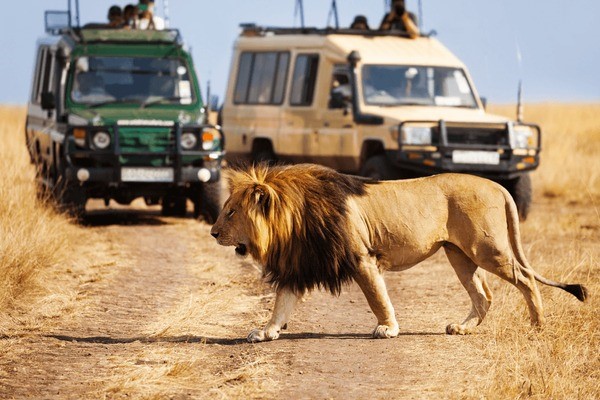Did you know that knowing how to plan a family safari in Africa can be one of the most thrilling and life-changing experiences for you and your loved ones?
So, let’s dive into the incredible world of safaris, and let Naicef show you how to plan a family safari in Africa like a pro!
Imagine the excitement of seeing the “Big Five” up close; lions, elephants, leopards, buffaloes, and rhinoceroses just by knowing how to plan a family safari in Africa.
But before you pack your bags, there are a few essential steps you need to know about how to plan a family safari in Africa.
Many travelers often find themselves overwhelmed with options and decisions when it comes to organizing such a once-in-a-lifetime adventure.
So, how to plan a family safari in Africa and ensure everyone enjoys it from start to finish?
It’s all about thoughtful preparation, the right mindset, and understanding what Africa has to offer.
Planning a family safari in Africa isn’t just about booking a flight and picking a destination, it’s about crafting an unforgettable experience that will make memories for years to come.
Whether it’s your first safari or a repeat visit, knowing how to plan a family safari in Africa will make the difference between an okay trip and an extraordinary one.
With the right information, a safari in Africa can be one of the best ways to connect as a family while also getting a taste of wild, untamed nature.
Are you still wondering where or how you can get to plan a Africa Safari? Worry less Naicef got your back!
What are you waiting for? Contact my@naicef.com or call +254799922277 for only the best experiences!
Book The Tour Here
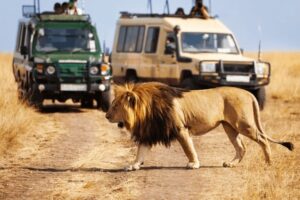
How To Plan Africa Safari
When it comes to how to plan Africa safari, there’s much more to consider than just the destination.
Choosing the right place, time, and accommodations can make a massive difference in how enjoyable the trip is for every member of your group.
To ensure that you get the most out of your African adventure, here’s a step-by-step guide on how to plan Africa safari.
1. Choose the Right Destination
Africa is a vast continent with diverse landscapes, ecosystems, and wildlife.
Some regions are more suited for certain travel styles than others, offering safe and comfortable accommodations, various activity levels, and better chances of spotting specific wildlife.
So, how to plan Africa safari, particularly when it comes to your destination?
- South Africa is often a top choice, with malaria-free zones, excellent infrastructure, and famous reserves like Kruger National Park.
- Kenya and Tanzania deliver the iconic East African safari experience, including the Great Migration and vast plains filled with wildlife.
- For something more exclusive, consider Botswana’s Okavango Delta or desert landscapes, ideal for those wanting less touristy, more off-the-beaten-path safaris.
It’s essential to take into account your travel group’s age range, interests, and physical needs.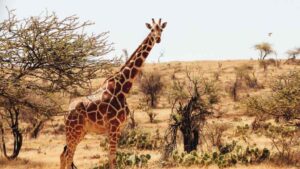
Some parks or lodges have age restrictions for game drives, while others offer specialized activities or guides tailored to different experience levels.
2. Pick the Right Time to Go
When considering how to plan Africa safari, timing is everything.
Africa offers year-round travel opportunities, but wildlife sightings and weather vary greatly by season and location.
- The dry season (May to October) is generally the best time for wildlife viewing. During this period, animals congregate around waterholes and rivers, making them easier to spot.
- The wet season (November to April) brings lush landscapes and vibrant birdlife, but also more rain, which can make some roads impassable and limit visibility in thick vegetation.
If you’re after big game sightings and comfortable weather, dry season is ideal.
But if you want fewer tourists and beautiful green scenery, the wet season can offer a unique and rewarding experience.
3. Book the Right Accommodations
Selecting the right lodging is a crucial part of how to plan Africa safari.
Whether you’re seeking luxury, eco-conscious options, or authentic bush experiences, the type of accommodation will define much of your safari.
- Luxury lodges provide comfort and service, often with private vehicles, gourmet meals, and high-end amenities.
- Tented camps offer a more rustic, close-to-nature feel, but with many still offering excellent service and comfort.
- Some mobile camps move with the migration, offering unbeatable wildlife experiences in exchange for slightly less predictability and comfort.
Make sure the lodge or camp aligns with your safari goals,
whether that’s photographing predators, birdwatching, or immersing yourself in local culture.
4. Plan the Travel Logistics
A key factor in how to plan Africa safari involves navigating the travel logistics.
Africa’s national parks and reserves are often located in remote areas, requiring extra planning.
- Most travelers fly into major hubs like Nairobi, Johannesburg, or Cape Town, followed by regional flights or overland transfers to their safari destination.
- Some safaris flights into bush airstrips, which means adhering to strict luggage size and weight restrictions, usually soft-sided bags only.
- Consider flight durations, layovers, and time zone changes. If you’re coming from far abroad, it’s wise to schedule a recovery day in a major city before your safari begins.
Taking care of these details early ensures that your safari is smooth and stress-free from start to finish.
What To Wear In Africa Safari
When thinking about how to plan a family safari in Africa, one of the most practical aspects is knowing what to wear.
Your safari clothes should be comfortable, practical, and suited to the weather conditions of the region.
Here’s a detailed breakdown of what to wear to ensure your family stays comfortable and protected throughout the trip.
Do’s
By do’s it means the type of clothes you are supposed to put on when you visit Africa.
Neutral, Light Colors:
When planning a family safari in Africa, it’s important to pack clothes in neutral colors like beige, khaki, brown, or olive green.
Bright colors like red or white can attract insects, and some animals might be startled by bright clothing.
Neutral colors blend in better with the natural surroundings, enhancing your safari experience.
Sun Protection Gear:
The African sun can be intense, so make sure to pack hats, sunglasses, and plenty of sunscreen.
A wide-brimmed hat is ideal for protecting your face and neck.
- Breathable Fabrics:
It’s hot during the day, and sometimes chilly at night, so pack light, breathable fabrics such as cotton or linen for daytime.
Layering is key, so bring a light jacket or sweater for the early mornings and evenings.
Comfortable Shoes:
For walking safaris or bush hikes, sturdy shoes with good support are essential. Closed-toed shoes will also protect your feet from thorns and insects.
Insect Repellent:
Mosquitoes can carry diseases like malaria, so it’s crucial to pack a good insect repellent to keep your family protected, especially in areas where malaria is present.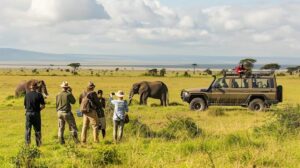 Don’ts
Don’ts
By do’s it means the type of clothes you are not supposed to put on when you visit Africa.
Avoid Dark Colors:
While it’s tempting to wear dark colors for their slimming effect, in a safari setting, they absorb heat and can attract more insects, especially mosquitoes.
No Flashy Jewelry or Perfume:
Flashy accessories can distract from the nature experience and might even make animals uncomfortable. Strong perfumes can also attract unwanted attention from insects.
Don’t Overpack:
You won’t need a lot of clothes. In fact, fewer, high-quality items are better for your family’s safari wardrobe. Plan to wash clothes between activities if needed.
Avoid Flip-flops and Sandals:
Open-toed shoes can leave your feet vulnerable to bites or scratches, especially in the bush or during game drives.
No Camouflage:
Some parks restrict visitors from wearing camouflage because it can resemble military attire. Stick to neutral tones.
Africa Safari Packing List
So, how to plan a family safari in Africa also involves knowing what to pack.
You want to make sure you have all the essentials without overloading yourself with unnecessary items. Here’s a comprehensive Africa packing list to make sure you’re covered for every safari adventure.
Here’s a comprehensive Africa packing list to make sure you’re covered for every safari adventure.
- Documents: Passport, visas, travel insurance, and copies of your bookings, all must-haves on any Africa packing list.
- Clothing: Neutral clothing, lightweight layers, and a swimsuit if your lodge has a pool. Practical and comfortable choices are key on your Africa packing list.
- Toiletries: Sunscreen, insect repellent, lip balm, and travel-sized toiletries. These items are essentials on every Africa packing list.
- Health Kit: Malaria medication (if needed), pain relievers, bandaids, and any prescription medications.
- Cameras & Binoculars: A good camera with extra memory cards and a pair of binoculars for wildlife viewing.
- Chargers & Adapters: Africa uses different plug types, so make sure to bring adapters. Don’t forget a portable power bank.
- Books & Kids Entertainment: If you’re traveling with kids, bring books or games for downtime.
- Small Daypack: A small bag for carrying essentials during day trips or game drives.
Whether you’re a first-time visitor or a seasoned traveler, keeping this Africa packing list in mind will help ensure a smooth and memorable safari experience.
How To Pack For A Safari To Africa
When you start thinking about how to pack for a safari to Africa, you’ll want to ensure that your bags are both practical and efficient.
It’s important to remember that many safari lodges or camps have luggage weight restrictions (usually around 15 kg per person).
This means you’ll need to pack wisely and prioritize essentials without overloading yourself.
One of the key tips for how to pack for a safari to Africa is choosing the right luggage.
Hard-shell suitcases aren’t ideal due to limited storage space and luggage restrictions on the small charter planes that shuttle guests between locations.
Instead, soft-sided duffel bags or backpacks work perfectly, allowing for easier handling and better flexibility.
Another crucial aspect of how to pack for a safari to Africa is making sure your most important items, like medications, cameras, and travel documents are always with you.
Pack these essentials in your carry-on luggage to avoid any chance of loss or delay, especially given the remote locations you’ll be visiting.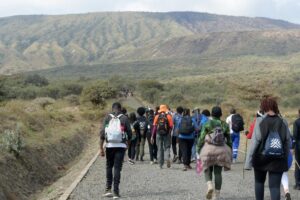 Because temperatures can fluctuate dramatically, knowing how to pack for a safari to Africa means preparing for both warm days and cool mornings or evenings.
Because temperatures can fluctuate dramatically, knowing how to pack for a safari to Africa means preparing for both warm days and cool mornings or evenings.
Layering is key: bring lightweight clothing for the daytime heat, along with a jacket or fleece for early morning game drives when the air can be quite chilly.
Finally, when considering how to pack for a safari to Africa, don’t forget the extras that will make your experience comfortable and safe such as a good pair of sunglasses, sunscreen with high SPF, and a wide-brimmed hat to protect you from the intense sun.
By carefully planning and knowing exactly how to pack for a safari to Africa, you’ll be ready to enjoy your adventure fully, without the stress of missing important items or carrying unnecessary weight.
Below are some of the itineraries of three major safari destinations in Africa:
Family Safari Adventure Across Three Destinations in Africa
Embark on a thrilling multi-country safari adventure through three of Africa’s most iconic wildlife destinations.
This sample itinerary offers a well-balanced journey with rich wildlife viewing, cultural immersion, and family-friendly activities in Kenya, Tanzania, and South Africa.
Perfect for families, this itinerary ensures smooth transitions, engaging experiences for children, and a taste of the continent’s diverse landscapes and cultures.
Destination 1: Kenya – Masai Mara National Reserve
| Day | Activity | Location | Details |
| 1 | Arrival in Nairobi | Nairobi, Kenya | Airport pickup, transfer to hotel, family welcome dinner |
| 2 | Transfer to Masai Mara | Masai Mara National Reserve | Light aircraft flight; check-in at family-friendly lodge |
| 3 | Morning & Afternoon Game Drives | Masai Mara | Search for lions, elephants, and giraffes; picnic lunch |
| 4 | Maasai Village Visit & Cultural Activities | Near Masai Mara | Learn traditional dances, crafts, and local life |
| 5 | Bush Walk & Wildlife Education for Kids | Private Conservancy | Child-focused nature walk and junior ranger program |
Destination 2: Tanzania – Serengeti & Ngorongoro Crater
| Day | Activity | Location | Details |
| 6 | Cross into Tanzania via land or flight | Serengeti National Park | Scenic drive or short flight; arrive at tented safari camp |
| 7 | Full-Day Safari in Serengeti | Serengeti | Track migrating herds and predators; family photography fun |
| 8 | Transfer to Ngorongoro Crater | Ngorongoro Conservation Area | Stop at Olduvai Gorge; arrive at crater rim lodge |
| 9 | Crater Exploration & Picnic | Ngorongoro Crater | Full-day game drive inside the crater; picnic lunch near hippo pools |
| 10 | Visit Local School or Community Project | Karatu | Cultural immersion; educational activity for kids |
Destination 3: South Africa – Greater Kruger National Park
| Day | Activity | Location | Details |
| 11 | Flight to Johannesburg, South Africa | Johannesburg | Overnight in city, rest and regroup |
| 12 | Travel to Greater Kruger Safari Lodge | Greater Kruger Area | Transfer to private lodge with kids’ safari programs |
| 13 | Game Drives & Lodge Activities | Greater Kruger | Big Five spotting; pool, crafts, or junior ranger activities at lodge |
| 14 | Bush Breakfast & Nature Walk | Greater Kruger | Morning bush meal followed by gentle guided walk |
| 15 | Return to Johannesburg & Departure | Johannesburg | Internal flight and international departure |
This itinerary gives families a rich taste of East and Southern Africa, combining wildlife, culture, and learning opportunities across three legendary safari regions.
Conclusion
In conclusion, planning a family safari in Africa is a truly beautiful blend of excitement, adventure, and careful preparation.
It is an opportunity not only to witness some of the world’s most spectacular wildlife and landscapes but also to strengthen family bonds through shared experiences in nature’s most breathtaking settings.
Understanding how to plan a family safari in Africa thoroughly will ensure that your trip becomes an unforgettable journey filled with joy, laughter, awe, and countless moments of wonder.
From the earliest stages of deciding where to go and when, to researching family-friendly accommodations and activities, every step plays a crucial role in shaping a successful safari experience.
Knowing how to plan a family safari in Africa includes thoughtful consideration of what to wear, ensuring the right clothing and gear are packed to face the often-variable weather and rugged terrain.
Equally important is assembling a comprehensive packing list tailored for the whole family, with essentials ranging from sun protection and insect repellent to entertainment for children during downtime.
Moreover, learning how to pack efficiently means you can avoid the stress of carrying heavy or unnecessary items, leaving you free to focus on the magic of your surroundings.
Each element from careful planning to packing smartly contributes to a smooth, enjoyable, and safe adventure that everyone in the family can appreciate.
But beyond the logistics, a family safari in Africa offers something far more valuable: the chance to create lifelong memories together.
Watching your children’s eyes light up at the sight of a herd of elephants, sharing stories around a campfire under a sky filled with stars, and feeling the quiet hum of the wilderness all contribute to an experience that will stay with you for years to come.
So, as you prepare to embark on this incredible journey, embrace both the excitement and the preparation.
Take the time to plan thoughtfully, pack wisely, and anticipate the incredible moments ahead.
Your family is about to step into the heart of the wild, where nature’s wonders await and unforgettable memories are just around the corner.
Get ready to explore, connect, and discover because this safari adventure will not only open your eyes to the beauty of Africa but will also deepen the connections within your family, enriching your lives in ways that only travel and shared adventure can achieve.
Contact my@naicef.com or call +254799922277 only for the best tips and safari tours to Africa!
Book The Tour Here
Frequently Asked Questions
1. What is the best time of year for a family safari in Africa?
The dry season (May to October) is considered the best time for wildlife viewing, as animals congregate around water sources.
2. Is it safe to go on a family safari in Africa?
Yes, Africa is generally safe for family safaris, especially in well-managed reserves. Always follow safety advice and choose reputable tour operators.
3. How long does a family safari in Africa typically last?
A typical family safari lasts between 7 to 10 days, but it can be shorter or longer depending on your preferences.
4. What vaccinations are needed for a family safari in Africa?
Common vaccinations include Yellow Fever, Typhoid, and Hepatitis A. It’s best to consult with a travel doctor for personalized advice.
5. What should I bring for my kids on safari?
Essentials for kids include sun protection, insect repellent, comfortable clothing, and entertainment for downtime.
